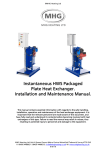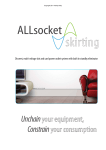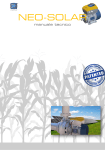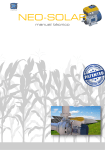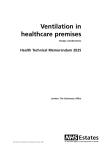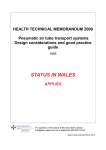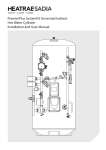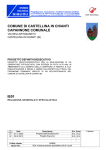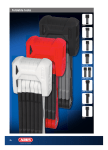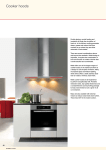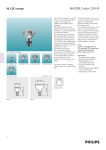Download Sports Centre: building user guide
Transcript
2013 University of Cambridge SPORTS CENTRE: BUILDING USER GUIDE Madingley Road, Cambridge University West Campus, CB3 0ES SPORTS CENTRE: BUILDING USER GUIDE [Type text] Page 2 SPORTS CENTRE: BUILDING USER GUIDE The project team Client: Project Management: Contract Administrator: Architect, Structural Engineer, M&E, Landscaping: Main Contractor: Quantity Surveying: [Type text] Page 3 SPORTS CENTRE: BUILDING USER GUIDE [Type text] Page 4 SPORTS CENTRE: BUILDING USER GUIDE Contents Purpose of this Building User Guide (BUG) ...................................................................................... 7 General Description of Building ......................................................................................................... 7 Floor usage summary.................................................................................................................... 7 Building Services Information............................................................................................................ 9 General Users ............................................................................................................................... 9 Heating and cooling ................................................................................................................... 9 Ventilation .................................................................................................................................. 9 Lighting ...................................................................................................................................... 9 Lifts .......................................................................................................................................... 10 Facilities Management ................................................................................................................ 10 Heating .................................................................................................................................... 10 Cooling .................................................................................................................................... 10 Ventilation ................................................................................................................................ 11 Lighting .................................................................................................................................... 14 Lighting Controls ...................................................................................................................... 15 External Lighting ...................................................................................................................... 16 Daylighting ............................................................................................................................... 16 Lifts .......................................................................................................................................... 16 Emergency Information ................................................................................................................... 18 General Users ............................................................................................................................. 18 Facilities Management ................................................................................................................ 19 Emergency Escape Lighting .................................................................................................... 19 Fire Detection and Alarm Systems ........................................................................................... 19 Accidents ................................................................................................................................. 19 Energy & Environmental Strategy ................................................................................................... 20 General Users ............................................................................................................................. 20 PV ........................................................................................................................................... 20 Facilities Management ................................................................................................................ 20 Monitoring ................................................................................................................................ 20 PV ........................................................................................................................................... 21 Water Use....................................................................................................................................... 22 General Users ............................................................................................................................. 22 [Type text] Page 5 SPORTS CENTRE: BUILDING USER GUIDE Facilities Management ................................................................................................................ 22 Mains Cold Water .................................................................................................................... 22 Water Storage ......................................................................................................................... 22 Domestic Water Systems......................................................................................................... 22 Domestic Hot Water System .................................................................................................... 23 Transport Facilities ......................................................................................................................... 24 General Users ............................................................................................................................. 24 Alternative modes .................................................................................................................... 24 Facilities Management ................................................................................................................ 25 Materials & Waste Policy ................................................................................................................ 26 General User ............................................................................................................................... 26 Battery Sets ............................................................................................................................. 26 Facilities Management ................................................................................................................ 26 Lamps...................................................................................................................................... 27 Battery Sets ............................................................................................................................. 27 Re-fit/Re-arrangement Considerations............................................................................................ 28 General Users ............................................................................................................................. 28 Facilities Management ................................................................................................................ 28 Reporting Provision ........................................................................................................................ 29 General Users ............................................................................................................................. 29 Facilities Management ................................................................................................................ 29 Training .......................................................................................................................................... 30 General Users ............................................................................................................................. 30 Facilities Management ................................................................................................................ 30 Links & References......................................................................................................................... 32 General ........................................................................................................................................... 33 [Type text] Page 6 SPORTS CENTRE: BUILDING USER GUIDE Summary Purpose of this Building User Guide (BUG) This ‘Building User Guide’ (BUG) contains the necessary details about the everyday operation of the building in a form that is easy to understand for the intended building users; University of Cambridge students and staff, visitors and facilities management (FM) personnel. The overall aim is to ensure that design features are used efficiently and that changes to the building are managed in an appropriate manner. By providing this information and guidance, it is more likely that the building will be used efficiently, that occupants will be satisfied with the building and that there will be less wastage of resources. This BUG has been developed in accordance with the compliance criteria for BREEAM credit Management 4. This BUG is, in addition to the health and safety file required by the Building Regulations Part L, to be provided to the owner and/or occupier of the building. This BUG is also, in addition to the Health and Safety file, required by the Construction Design and Management Regulations to be passed onto the building user on completion. General Description of Building The Cambridge Sports Centre comprises the £16 million Phase One of the West Cambridge University Masterplan. The sports centre entrance lobby and reception contains a media wall for TV and building user information. A café occupies part of the lobby space for the enjoyment of all, either pre or post-game. From this area, through a glass partition, is visible the fitness suite with a full range of state-of-the-art cardiovascular equipment. At the core of the Centre is an 8 court multipurpose sports hall, with court marking to include badminton, basketball, volleyball, netball, Korfball, five-a-side football and other court games. There is a strength and conditioning wing, with free-weights platforms and a two-lane plyometric track. A large multi-purpose room caters for the martial arts, yoga, spinning, and floor-based exercises including fencing, dancing and gymnastics. Floor usage summary 2 6,060m gross internal area (GIA) 2 4,600m dedicated sports and recreation facilities [Type text] Page 7 SPORTS CENTRE: BUILDING USER GUIDE Entrance foyer Multipurpose sports hall Fitness suite Weights room Squash courts Multiple changing rooms Health suite Equipment store First aid Offices Plant and facilities areas Multipurpose room Fencing & table tennis Fives courts Stores Offices Viewing gallery Plant rooms [Type text] Page 8 SPORTS CENTRE: BUILDING USER GUIDE Building Services Information Building Services Information Internal design temperatures within each space vary due to nature of sports events and different uses within the building. The criteria shown in the adjacent table are based upon various CIBSE and Sport England Guides. The following table provides a summary of the required internal design conditions. Space Heating temperature Cooling temperature Ventilation General space 19°C Up to +3°C above ambient Naturally ventilated Main sports hall 12-16°C Up to +3°C above ambient Fitness centre 18°C 20±2°C Weights room 18°C 20±2°C Changing rooms 20-25°C Up to +2°C above ambient Multipurpose room 18°C 20±2°C Mechanical ventilation: up to 10l/s/person, or, 0.5 air-changes/hour Mechanical ventilation: up to 20l/s/person Mechanical ventilation: up to 20l/s/person Mechanical ventilation: 10 air-changes/hour Mechanical ventilation: up to 20l/s/person General Users Effective heating and cooling systems are important to provide a comfortable indoor environment. Heating and cooling The temperature is monitored by sensors connected to the building management system (BMS). If you wish to adjust the temperature then contact a member of facilities management staff. Relevant contact details can be found at the rear of this document. Ventilation The UoC sports centre is a mixed mode building which can be naturally ventilated when conditions allow. To maintain conditions, a full fresh air mechanical ventilation system is also provided. Ventilation requirements are monitored by sensors connected to the building management system (BMS). If you wish to adjust the ventilation then contact a member of facilities management staff. Relevant contact details can be found at the rear of this document. Do not block the flow of air either into or out of the ventilation grilles as this can affect the ability of the heating/cooling system to work effectively therefore wasting energy. Lighting Presence detection is provided within all store rooms, cleaners cupboard, server and repro room, staircases, circulation routes, lift, WC’s, showers and changing rooms. Absence detection is installed within all offices, meeting rooms, first aid room, fitness suite, and weights room. Plant rooms manually switch for the purposes of safety. [Type text] Page 9 SPORTS CENTRE: BUILDING USER GUIDE Some internal spaces with windows are installed with daylight linking in order to achieve a high building lighting energy efficiency. Where dimmable luminaries are supplied the daylight linking will dim the internal luminaires to predetermined levels in order to achieve the targeted illuminations. All spaces with daylight linking are provided with manual overrides for maximum flexibility. Lifts The University of Cambridge Sports Hall building is provided with a single 21 person 1700Kg machine-roomless evacuation lift. The lift car has a clear door opening width of 1400mm and a clear height of 2100mm to allow transportation of specialist sports equipment identified by the University. The lift speed is 0.5m/s. Do not exceed the maximum capacity. Do not operate the lifts in a fire or when instructed for other reasons. In case of emergency use the communication panel within the lifts to call for assistance. Facilities Management Heating The primary heating source for the building is modular gas fired condensing boilers. The boilers are located in the ground floor plant room (southeast). The primary heating source for the building is modular gas fired condensing boilers with primary pumps feeding a low loss header. The operating temperatures of the LTHW heating system are 60/40°. The building heating requirement is 340kW: therefore 3no. 140kW (heat output) boilers are used. This provides an additional 25% capacity as required by the University of Cambridge Estate Management Design and Standards guide. The boiler circuit is provided with pressurisation set, de-aerator, dirt separator and dosing pot. Pumped secondary heating circuits are provided for the following; AHU circuit – Constant temperature, variable volume circuit for AHU heating coils. Radiator/Radiant Panel Heating circuit – Constant temperature, variable volume circuit. Variable volume pumps are inverter driven and all pumps are duplicate sets for run and standby operation. All pumps are of single head type. Pressure differential control valves are provided to AHU branches and specific locations for the radiator circuit as detailed on the schematics. Valved connection points are provided for the future possible interconnection of CHP pipework from the future phase 3 swimming pool construction. Cooling Variable Refrigerant Volume (VRV) / Variable Refrigerant Flow (VRF) systems are provided for space and air handling plant cooling requirements. External condensing units are located in louvered areas at first floor plant room level below the roof line. Vents are provided in the roof over these areas to allow for the required heat rejection. Space provision is allocated for the future installation of a condenser unit for the future multipurpose area. Condenser units are provided and connected to spaces to minimize the number of units required. Space has been allocated based on the following; [Type text] Page 10 SPORTS CENTRE: BUILDING USER GUIDE First Floor West First Floor East Multipurpose West / Server 45kW (1no. condenser) Weights / Office / Server 45kW (1no. condenser) Future Multipurpose 40kW (space for 1no. condenser) Fitness AHU load 135 kW (3no. condensers) Multipurpose East 40kW (1no. condenser) The VRV/VRF system for the weights and multispace areas also provides space heating when required, reducing the required load for heating from gas fired boilers. The changing rooms are designed to use integrated cooling units which are to use R134A refrigerant and are required to operate at a COP of 4.6. All other VRV/VRF systems have externally located condensers and are to use R410A refrigerants. The Fitness Suite bank of outdoor condenser units is required to operate at a minimum EER of 3.48. All other units shall be individual and are required to operate at a minimum EER of 4.13. Ventilation Sports hall The sports hall is a mixed mode space which can be naturally ventilated when conditions allow. Rooflights at high level within the space are motorised and BMS controlled. They operate in conjunction with four ducted inlets located above head height on the ground floor. At extreme low ambient external temperatures, the natural ventilation openings are controlled closed and LTHW radiant heating panels operate. Each row of radiant panels is controlled by 2 port motorised valves operating from ‘black bulb’ temperature sensors. [Type text] Page 11 SPORTS CENTRE: BUILDING USER GUIDE To maintain conditions, a full fresh air mechanical ventilation system is also to be provided. The air plant is located in ground floor plant rooms and provided with attenuators, panel and bag filtration, hygroscopic thermal recovery wheel, LTHW frost and re-heat coils. In winter, the air is tempered to 3° below the target temperature of the radiant panels. CO2 space sensors control fresh air plant, which provide filtered and tempered fresh air to the space. Air is ducted to the sports hall via corridor ceiling voids and introduced by side wall ‘eye ball’ type jet nozzle diffusers. Extract air is from the highest possible level at one end of the hall via. architectural wall panels. The mechanical ventilation also operates at high ambient external temperatures with the radiant panels controlled ‘off’. Dependent on wind, rain, temperature and CO2, the mechanical ventilation is controlled ‘off’ by the BMS and the natural ventilation modulated as required via the low and high level openings. A user override switch will be located in the reception back office to allow the BMS control to be overridden. Figure 1: Natural ventilation concept. Fitness suite The fitness suite requires temperature and humidity control within the space and is subjected to high sensible and latent heat loads. To maintain conditions, a full fresh air mechanical ventilation system is provided. The air plant is provided with attenuators, panel and bag filtration, hygroscopic thermal recovery wheel, VRV/VRF cooling coil and LTHW frost and re-heat coils. [Type text] Page 12 SPORTS CENTRE: BUILDING USER GUIDE The air handling unit is located in the first floor east plant room. Air intake is via an architectural weather louvre. A ductwork plenum to the rear of the louvre enables multiple air plant duct connections. The exhaust ductwork is discharged into the external condenser enclosure via an exhaust plenum and weather louvre. Intakes and exhausts are designed to keep maximum spacing between them to avoid short circuiting. Supply and extract ductwork is routed above the multipurpose stores at first floor level and drops down in dedicated risers to serve the fitness suite. The risers are half hour fire rated and fire dampers are required where ducts pass through the first floor slab. Supply air is introduced to the space via exposed duct mounted adjustable radial diffusers with core tube for turbulent mixing of the air. Extract air is via side wall bar grilles located at each end of the space. An extract branch is also provided to the fitness staff office with supply air transferred from the main space via a transfer duct and cross talk attenuator. Cooling to the staff office is via a wall mounted VRV/VRF room unit. Multipurpose The multipurpose space is a mixed mode space which can be naturally ventilated when conditions allow. The space can be subdivided into two separate individual spaces and the services are provided to cater for different uses. Rooflights at high level within the space are motorised and BMS controlled and operate in conjunction with user operated windows. To maintain conditions, a full fresh air mechanical ventilation system is also provided. The air plant is located in the first floor plant room and will be provided with attenuators, panel and bag filtration, hygroscopic thermal recovery wheel, VRV/VRF cooling coil and LTHW frost and re-heat coils. Air intake is via an architectural weather louvre. A ductwork plenum to the rear of the louvre enables multiple air plant duct connections. The exhaust ductwork is discharged into the external condenser enclosure via an exhaust plenum and weather louvre. Intakes and exhausts are designed to keep maximum spacing between them to avoid short circuiting. Dependent on wind, rain, temperature and CO2, the mechanical ventilation will be controlled ‘off’ by the BMS and the natural ventilation modulated as required via the low and high level openings. A user override switch is located in the reception to allow the BMS control to be overridden. Space heating is provided by the air handling plant. Weights To maintain conditions, a minimum fresh air mechanical ventilation system with ceiling mounted local terminal VRV/VRF heating/cooling units is provided. The air plant is provided with attenuators, bag filtration, hygroscopic thermal recovery wheel and LTHW frost and re-heat coils. The air handling unit is located in the first floor west plant room. Air intake is via an architectural weather louvre. A ductwork plenum to the rear of the louvre enables multiple air plant duct connections. The exhaust ductwork is discharged into the external condenser enclosure via an exhaust plenum and weather louvre. Intakes and exhausts are designed to keep maximum spacing between them to avoid short circuiting. The air handling plant space is restricted and the layouts have been designed around a specific ‘cabinet’ type air handling unit. Supply and extract ductwork is routed within ceiling voids above the ground floor changing rooms and corridor. Fire dampers are required where ducts pass through the first floor slab. Tempered supply air is introduced to the space via ceiling mounted diffusers. Extract air is also via ceiling mounted diffusers. [Type text] Page 13 SPORTS CENTRE: BUILDING USER GUIDE Room terminal cooling units are either be 4-way type cassette units mounted or concealed within ceiling void and ducted to supply / extract grilles. Changing rooms As per the weights room. In summer peak, to avoid overheating to the space, air will be supplied to the space at a maximum temperature of 20°. Heating to the changing rooms will be via underfloor LTHW heating systems, provided with local manifold, mixing valve and pump arrangement. Members/fitness suite: The air handling unit for the fitness changing is located in the first floor west plant room. Sports hall: The air handling unit for the sports hall changing is located in the ground floor east plant room. Reception and café area The reception and café are is a naturally ventilated space. Openable windows are provided for local control. This area has underfloor heating. Overhead LTHW warm air door heaters are also provided to prevent discomfort when external doors are opened. Offices The office spaces are naturally ventilated and are provided with openable windows suitable for winter minimum background ventilation and summertime maximum ventilation. LTHW radiators with thermostatic control valves are provided for heating. 1st floor WC’s Toilets are provided with mechanical extract ventilation and local LTHW low surface temperature radiators (where necessary) with thermostatic control valves. Server room Dedicated VRF systems will be provided to the server room on the first floor sized for a maximum 4kW sensible cooling capacity. Lighting General Internal Lighting General artificial lighting is provided in all areas of the building in accordance with the guidelines of the University's Design and Standards Brief. The luminaires are selected to provide energy efficiency balanced with a high level of lighting quality. The primary light sources utilised are linear fluorescent T5, compact fluorescent, and LED. Linear fluorescent, compact fluorescent and LED luminaires are provided with high frequency Dali dimmable ballasts where lights are adjacent to windows. All LED luminaires are provided with passive cooling. Sports lighting The University has requested the capability for the Sports Hall to allow training at the highest event class with the most stringent lighting criteria. The Class requirements and descriptions for the various sports are shown in the Table 1: Sports [Type text] Class I (Lux) Class II (Lux) Class III (Lux) Uniformity (Emin/Eav) Colour Rendering Index Page 14 SPORTS CENTRE: BUILDING USER GUIDE Badminton Basketball Dancing/Aerobics Fencing Five-a-side Football Gymnastics Handball Martial Arts Netball Table Tennis Volleyball Wall Climbing * Wrestling 750 750 500 750 500 500 300 500 300 200 200 200 0.7 0.7 0.7 0.8 60 60 60 60 750 500 200 0.7 60 500 750 750 500 750 750 500 750 300 500 500 200 500 500 300 500 200 200 200 75 300 200 200 200 0.7 0.7 0.7 0.7 0.7 0.7 0.8 0.7 60 60 60 60 60 60 60 60 Table 1: Class requirements and descriptions for various sports Lighting Class I – International and national competition, large spectator capacities with long viewing distances, top level supervised training. Lighting Class II – Mid-level competition; principle local clubs and county regional competition, medium level spectator capacities with medium viewing distances, high level supervised training. Lighting Class III – Low-level completion; local or small club competition, minimal or no spectator provision, general training; school sports and recreational activities. Badminton has the most onerous criteria for artificial lighting in each of the classes, along with the most stringent criteria of where the luminaires can be located within the sports hall. For this reason the lighting within the main Sports Hall has been designed to the requirements of Class I badminton for training and events. The lighting controls allow the lighting level to be adjusted for training, other classes of event and other sports. High bay downlights incorporating high efficiency metal halide lamps are provided within the main Sports Hall to achieve Class I levels of the illumination along with flexibility to allow energy savings during periods when Class I lighting is not required. The lighting within the Multipurpose room has also been designed to a Class II level of lighting for training and competition; here martial arts has the most onerous criteria and determining the design parameters. The lighting is provided by high bay downlighters incorporating high efficiency metal halide lamps. Lighting Controls A lighting control system comprising of daylight linking, presence detection, absence detection and manual switching has been installed throughout the building. Presence Detection Presence detection is provided within all plant rooms, store rooms, cleaners cupboard, server and repro room, staircases, circulation routes, lift, WC’s, showers and changing rooms. Presence detection detects a person entering the space/room and automatically switches ‘on’ the lighting within the room. The lighting then remains ‘on’ for a predetermined time period after which the lighting control system will switch ‘off’ the lighting. If the presence detector is reactivated by movement during the predetermined time period, the time period is reset and restarts; the lighting remaining ‘on’. Absence Detection Absence detection is installed within all offices, meeting rooms, first aid room, fitness suite, and weights room. [Type text] Page 15 SPORTS CENTRE: BUILDING USER GUIDE Absence detection relies on a manual input from the user to bring the lights ‘on’ if required. The lighting control system then monitors the occupancy of the space and switches the lighting ‘off’ if no occupancy is detected for a predetermined time period. This can be combined with daylight linking to automatically dim the lights following a manual user input. A second manual input then overrides the daylight linking to bring the lighting ‘on’ to 100%. Daylight Linking All internal spaces with windows are installed with daylight linking in order to achieve a high building lighting energy efficiency. Where dimmable luminaries are supplied the daylight linking will dim the internal luminaires to predetermined levels in order to achieve the targeted illuminations. Daylight linking within the main Sports Hall utilises switching instead of dimming as these luminaires cannot be dimmed. The luminaires are divided into three groups to provide four different levels of artificial lighting: All luminaires ‘off’ – Sports Hall in natural daylighting mode, 33.3% of luminaires ‘on’ – Part daylighting or Class III lighting mode, 66.6% of luminaires ‘on’ – Part daylighting or Class II lighting mode, 100% of luminaires ‘on’ – Class I lighting mode All spaces with daylight linking are provided with manual overrides for maximum flexibility. External Lighting External lighting is provided to the landscaping around the main entrance, parking, access road and above all exit doors. This lighting comprises of: Compact fluorescent pole top luminaires for the access road and car parking, Compact fluorescent bollard luminaires for way finding around the cycle parking and main entrance, Wall mounted compact fluorescent over door luminaires for all exit doors. Daylighting The University of Cambridge Sports Hall has been optimised to maximize the use of daylighting, utilising the north facing windows to light the main sports and multipurpose halls. In addition to this the Entrance Foyer, Café and fitness suite have a large north facing glazed facade permitting indirect light into the spaces. Areas such as the Weights room and the Offices also benefit from large areas of glazing permitting natural light into the spaces. In order to achieve reduced lighting energy consumption through the use of daylight the above spaces will be provided with automatic daylight linking. This is described in more detail within the Lighting Controls Section. Metering System The BMS interfaces with the buildings electrical consumption meters via a serial interface (Modbus). The BMS interfaces with the buildings gas and water consumption meters via pulse contacts supplied with the meters. The BMS will display the consumption data for each meter on a daily, weekly and monthly basis. The AHUs all have a heat meter installed to measure the energy consumed by each AHU. The LTHW circuits all have a heat meter installed to measure the energy consumed by each circuit. The meters are monitored by the BMS via a serial interface. The BMS displays the energy data associated with each meter. Lifts The University of Cambridge Sports Hall building is provided with a single 21 person 1600Kg machine-roomless evacuation lift. The lift car has a clear door opening width of 1400mm and a clear height of 2100mm to allow transportation of specialist sports equipment identified by the University. The lift speed is 0.5m/s. [Type text] Page 16 SPORTS CENTRE: BUILDING USER GUIDE The lift has two power supplies, provided via an automatic changeover switch. The primary supply is fed directly from the main LV switchboard. The secondary supply is derived from a UPS system within the Sports Hall building. It should be noted that UPS systems require regular maintenance and testing to give the best reliability in the event of a power failure. The lift communications system is linked via BT Redcare line to University's Central Control Room [Type text] Page 17 SPORTS CENTRE: BUILDING USER GUIDE Emergency Information Emergency Information PLEASE CALL 999 IN AN EMERGENCY For non-emergencies: Police Parkside Police Station Parkside Cambridge CB1 1JG Tel: 101 Opening times: Mon - Sun; 8am - 10pm Bank holidays; 9am - 5pm Fire Cambridge Fire Station TA centre Coldham's Lane Cambridge CB1 3HS Tel: Out of hours: Ambulance 01223 403 630 01223 403 631 Addenbrooke's Cambridge University Hospitals NHS Foundation Trust Cambridge Biomedical Campus Hills Road Cambridge CB2 0QQ Tel : 01223 245 151 General Users On discovering a fire or hearing the fire alarm the building should be evacuated immediately via your nearest available Fire Exit. Do Not use the lifts Do Not stop to collect personal belongings Ensure that any doors are shut behind you and proceed to your designated muster point. Remain at the muster point and do not enter the building until an Evacuation Officer communicates it is safe to do so. All emergency exit routes are signposted. On making the decision to evacuate each person should exit the building and proceed to the Muster Point located to the north of the building, unless an alternative is specified. Fire Extinguishers and similar fire fighting systems should only be used by members of staff who have undertaken the necessary training. They are located throughout the building. [Type text] Page 18 SPORTS CENTRE: BUILDING USER GUIDE Accidents In the event of an accident contact either the First Aider or the emergency services. First aid rooms are available. To use a first aid room, contact a first aider who will assist. If you have an accident or a near miss that you feel was potentially serious, it is important you complete an accident or near miss form and submit it to Health and Safety. Facilities Management Emergency Escape Lighting Emergency lighting is provided throughout the building to meet the requirements of BS 5266 comprising of luminaires with self contained 3 hour batteries operating automatically under a mains or local circuit failure condition. Where possible these luminaires are the luminaires providing the general illumination of the space. Where this is not possible a proprietary surface mount or recessed LED escape luminaire is provided. Internally illuminated emergency escape signage is provided throughout the building in accordance with BS 5266. Fire Detection and Alarm Systems At the request of the University Fire Safety Unit, a category L2, analogue addressable automatic fire detection and alarm system is provided in accordance with BS 5839 and the University's Design Standards and Brief. The system comprises smoke detectors, heat detectors, electronic sounders, beacons, manual call points, and interfaces to all BMS controls panels, audio equipment, and any door hold open devices. The fire alarm system is linked to the University's Central Security Control room via a Redcare system. The detection system covers the following areas: Escape Routes including the entrance foyer, weights room, escape stairs, escape corridors All rooms opening onto escape routes other than the sports hall Access rooms to inner rooms All store rooms and cleaners cupboards/rooms All plant rooms Manual call points are installed on all final exit doors and to the entrance lobbies of the escape staircases at first floor level. Fire detection within the main sports hall has been requested by the University Fire Safety Unit. A single main fire alarm control panel is provided behind the reception desk adjacent to the main entrance. The system is hard wired using approved fire rated cabling with a red low smoke zero halogen emitting outer sheath. An interface is provided to an automatic pager system to initiate a vibrating signal and text message via radio waves to pagers issued to people with impaired hearing upon arrival to the building. A private fire hydrant is provided off the existing mains water service feeding the site. Accidents The first aid room is located on the ground floor, northeast corner, adjacent to the entrance lobby. [Type text] Page 19 SPORTS CENTRE: BUILDING USER GUIDE Energy & Environmental Strategy Energy & Environmental Strategy The Cambridge University sports centre incorporates features which provide a range of sustainability outcomes, and achieved a BREEAM ‘Excellent’ rating. The reasons for using energy-efficient features and strategies are: Cambridge University Sports policy and standing as an environmentally and socially conscious organisation To conserve the planet’s finite natural resources To achieve cost savings by minimising the site’s utility bills. General Users The University of Cambridge Sports Hall has been optimised to maximize the use of daylighting, utilising the north facing windows to light the main sports and multipurpose halls. In addition to this the Entrance Foyer, Café and fitness suite have a large north facing glazed facade permitting indirect light into the spaces. Areas such as the Weights room and the Offices also benefit from large areas of glazing permitting natural light into the spaces. Only switch the lights ON as and when necessary as they result in significant emissions of CO 2 into the external atmosphere, contributing to global warming. The heating and ventilation system is similarly controlled by the BMS. If you wish to change the lighting, heating or ventilation levels please contact a member of staff. PV The University of Cambridge Sports Centre has 78.75kWp of photovoltaic (PV) solar panels installed on the roof. The sports centre’s renewable energy requirement is based on predicted CO 2 emissions and aims to offset 10% of the development’s predicted annual CO2 emissions. Facilities Management The sports centre is designed to be better than the good practice benchmarks for energy consumption and CO2 emissions as set out in ECG 78 Sports and Leisure Buildings. These are as follows: Good practice benchmark Building energy consumption (MWh/year) Building CO2 emissions Electricity Natural gas Total energy 529 940 1,469 273,500 186,100 459,600 Table 2: Minimum energy and CO2 targets To achieve the minimum energy and CO2 performance targets the sports centre was designed to fabric Uvalues of: roof = 0.2; walls = 0.25; floor = 0.2, and; windows = 1.8. In addition, the building has an air 3 2 permeability rate of 3.93m /hr/m @ 50Pa. Monitoring In order to comply with the British Building Regulations the University of Cambridge Sports Centre building is provided with a metering system in accordance with CIBSE TM39. The metering system comprises of meters [Type text] Page 20 SPORTS CENTRE: BUILDING USER GUIDE interconnected by a Modbus metering network connected to the building management system (BMS) outstations. The meter readings are to be collated, represented and stored on a graphical user interface as part of the building management system. An aspect of virtual metering will need to be carried out by the BMS software to meet the requirements of TM39. PV The University of Cambridge Sports Centre’s renewable energy requirement is based on predicted CO 2 emissions and aims to offset 10% of the developments predicted annual CO2 emissions. The sports centre has 78.75kWp of photovoltaic (PV) solar panels installed on the roof. To provide this output there are 315 SOLON SOLraise Black 230/02 250Wp Mono-crystalline units. These are mounted in 12 strings and connected to 6 inverters, located on the roof. [Type text] Page 21 SPORTS CENTRE: BUILDING USER GUIDE Water Use Water Use General Users Water efficiency measures have been incorporated to avoid the wastage of water. Water efficient measures include: Infra red actuated taps Dual flush water closets Aerating showers Flow restrictors Water efficient ‘Dual Flush’ toilets are installed throughout the sports centre to reduce the quantity of water consumed for non-essential purposes. This reduces the impact on the environment and will save money on the water utility bill. All taps and showers are fitted with infra red sensors, flow restrictors and are aerated. This reduces water consumptions and therefore the impact on the environment. It will also save money on the water utility bill. Do not waste water. Facilities Management Mains Cold Water The Sports Centre is provided with a single mains water supply (MCWS) connection from the existing mains water service feeding the site from the eastern boundary. The incoming water supply is provided with an external meter pit which houses the main isolation valves and the Cambridge Water Company utility meter. The supply enters the building within the water storage plantroom at ground floor. All drinking water points within the building are supplied directly from the MCWS. In line with the Design and Standards Brief, water check meters with pulsed outlets monitored by the BMS system will be provided on the supply pipework to the water storage tank and the dedicated cold feed to hot water cylinders. Water Storage A GRP two compartment potable cold water storage tank fed from the MCWS is provided with an approximate 3 capacity of 56m within the ground floor plantroom. The tank has been sized to hold sufficient water to cover the opening times (6:30am/10:00pm) and predicted usage of the Sports Centre. The Cambridge Water Company (CWC) restriction of 3 litres/second to the site results in a tank refill time of approximately 5 hours. Domestic Water Systems A boosted cold water service (BCWS) is provided to all changing areas, toilets, staff areas, first aid room and plantrooms within the Sports Centre. This includes wash hand basins, cleaner’s sinks, showers, WC’s and a fill points for the mechanical plant. [Type text] Page 22 SPORTS CENTRE: BUILDING USER GUIDE The main domestic hot and cold water distribution pipework is distributed from the ground floor water storage plantroom to run horizontally within the services voids/corridors to all ground floor areas. The pipework to the first floor level rises in a dedicated riser to serve the staff toilet and cleaners sink. Isolation, flushing and injection points are provided at suitable locations to facilitate flushing through and sterilisation for future maintenance. Water efficiency measures have been incorporated to avoid the wastage of water. Water efficient measures include: Infra red actuated taps Dual flush water closets Aerating showers Flow restrictors Domestic Hot Water System A boosted domestic hot water flow and return service (BHWSF/BHWSR) is provided to all changing areas, toilets, staff areas and the first aid room. This includes lavatory basins, sinks and showers. The system water temperature is maintained at a minimum of 55°C with a pumped secondary hot water circulation system. Thermostatic mixing (TMV’s) valves are provided at all wash hand basins and showers. TMV’s will not be provided to sinks and cleaners sinks. The hot water is generated by two direct gas fired water heaters with a buffer vessel for each heater. [Type text] Page 23 SPORTS CENTRE: BUILDING USER GUIDE Transport Facilities Transport Facilities General Users Car and taxi – access to the University of Cambridge West Cambridge Site is from Madingley Road and the M11; access to the sports centre site is from Charles Babbage Road. Staff and patrons are encouraged to use alternative modes of transport if practicable. By doing so, the impact on the environment will be reduced. Parking - Parking is provided throughout the University of Cambridge West Cambridge Site. However, parking at the sports centre is limited to 10 parking bays, designated for use by disabled motorists, in order to encourage patrons to use alternative modes of transport. Setting Down Points - the arrival forecourt of the sports centre will include a vehicular setting down areas. Alternative modes Bus – A bus stop is located at the junction of Charles Babbage Road and the access road to the sports centre site. The 1, 2, 8, 77, 305, 314, 326,717, 797, C4, U4, X4, X5, bus routes pass along Madingley Road and connect to the city centre. Buses provide wheelchair access. Bus route information, including real time smartphone apps, can be found at the following webpage: http://www.cambridgeshire.gov.uk/transport/around/buses/. [Type text] Page 24 SPORTS CENTRE: BUILDING USER GUIDE Cycle – A cycle path along the canal colonnade connects to the city centre cycle network and continues over the M11 via a cycle/foot bridge. There are 188 cycle spaces provided for patrons of the UoC Sports centre. These are covered and lit, and provided with stainless steel ‘Sheffield’ style holders for two bikes. Four changing and locker rooms for males and females (two female and two male changing rooms) are provided on the ground floor of the sports centre, and a total of 401 lockers (of which 7 are accessible lockers and 12 d lockers) lockers are be provided, with 27 showers. Pedestrian – the Coton footpath connects the city centre (via Wilberforce Road) to the colonnade canal and continues over the M11 via a cycle/foot bridge. Facilities Management Access to the site is open to the public: car parking and cycle racks are not protected by any on site security features. There are 188 cycle spaces provided for patrons of the UoC Sports centre. These are covered and lit, and provided with stainless steel ‘Sheffield’ style holders for two bikes. Parking at the sports centre is limited to 10 parking bays, designated for use by disabled motorists, in order to encourage patrons to use alternative modes of transport. [Type text] Page 25 SPORTS CENTRE: BUILDING USER GUIDE Materials & Waste Policy Materials & Waste Policy Information on the location of recyclable materials storage areas and how to use them appropriately. General User The University of Cambridge Sports Centre has been designed to facilitate the collection of two waste streams: dry, mixed recyclables, and; residual waste. The mixed, dry recyclable waste stream includes materials such as paper, cardboard, glass, plastic, Tetra packs and cans. The residual waste stream includes all those remaining materials that cannot readily be recycled, including food and other organic wastes. Bins are located throughout the Sports Centre which will facilitate the source segregation of waste in to mixed, dry recyclables and residual waste. These bins have signage to encourage the participation of source segregation. All signage and bin colours are in line with other buildings within the West Campus. Cleaning teams will collect waste periodically throughout the day and transfer the waste to the large storage bins. Battery Sets Cells and batteries must be properly disposed of through an authorized lead disposal centre, on NO ACCOUNT must they be disposed of in general waste. Facilities Management As above, plus: Waste will be collected from the Sports Centre using a conventional container and vehicle system, in line with waste collection from the other buildings on the West Campus. In addition to the recyclable and residual waste streams, small amounts of other wastes will be produced by specific areas for which separate collection arrangements will have to be made by Facilities Management. These arrangements may be made with the environment office of the University Estate Management, and will include: Sanitary waste from WC’s Medical waste from first aid room Bulky waste (such as broken furniture or sports equipment) Waste electrical and electronic equipment (WEEE) such as toner cartridges, batteries and fluorescent tubes. The café is operated as a commercial operation. As such, the waste generated will need to be treated separately from that of the Sports Centre: this should be collected and stored separately and the operator of the café is responsible for arranging collection of this waste separately from that of the Sports Centre. Facilities Management are responsible for emptying the bins in the Sports Centre and transferring the bagged waste to the waste room, where it will be placed in the relevant 1,100 litre Eurobin. The waste rooms containing the waste storage bins are located at the North-East and North-West corners of the Sports Centre, and are access via external doors. Each room contains two storage bins (one room for [Type text] Page 26 SPORTS CENTRE: BUILDING USER GUIDE recyclable waste, and the other room for residual waste) and is 1,800mm by 3,300mm. They both have doorways with clear opening widths of 1,600mm and contain a tap and gulley for wash-down purposes. Contact your local authority to determine how and where fluorescent tubes and batteries can be disposed of carefully, safely and within the COSHH Regulations. Lamps Lamp disposal can damage your health and should comply with Control of Substances Hazardous to Health (COSHH) regulations. Fluorescent or sodium lighting is now considered a producer of hazardous waste and must be disposed of by a specialist company. Fluorescent tubes contain mercury, cadmium and lead, all recognised as very toxic metals. They can be very harmful to health, even in small quantities that can hardly be measured. They also easily and rapidly pollute water courses and the environment in general unless disposed of correctly. All failed lamps, bulbs and light filaments are to be collated in a lamp receptacle and disposal made via a specialist sub-contractor. Battery Sets Cells and batteries must be properly disposed of through an authorized lead disposal centre, on NO ACCOUNT must they be disposed of in general waste. Refer to the CONTROL OF POLLUTION ACT Special Waste Regulations. Contact your local authority to determine how and where fluorescent tubes and batteries can be disposed of carefully, safely and within the COSHH Regulations. [Type text] Page 27 SPORTS CENTRE: BUILDING USER GUIDE Re-fit/Re-arrangement Considerations Re-fit/Re-arrangement Considerations General Users Furniture can be rearranged temporarily according to staff needs. If furniture is moved then it should be relocated to its original position once the need for its rearrangement has ended. No member of staff should attempt to adjust or tamper with the power sockets throughout the office other than the designated, qualified technicians. No blockage of fire exists will be permissible as this represents a serious fire hazard. Any furniture located in this position must be moved immediately. No blockage of the ceiling or wall mounted ventilation grilles will be permissible. Blockage of grilles can cause damage to the ventilation system, impact the health and wellbeing of other building users and will increase the building’s consumption of energy. Where desks and computers are to be moved ensure that screen glare has been reduced and the workplace lighting is suitable. Facilities Management Although no building modifications are planned, it may be likely that new phases of re-arrangement, expansion and refit can be expected at a later date. In this instance, it is recommended that FM consider the ‘best practice’ environmental practices of the time, such as those outlined in the BREEAM standard. Practices to consider might include some of the following: The use of natural ventilation rather than air-conditioning Re-use of materials from the original construction (flooring, furniture and fittings) Use of environmentally certified materials (those in the Green Guide to Specification) Installation of renewable energy technologies Additional riser or duct space to assist future flexibility Installation of additional or best-practice systems that will remain suitable if user levels rise above those designed for Information on any future modifications made should be logged and securely stored for future reference. Information on environmental best-practices should be passed on to the personnel in charge of management decisions, so they are aware of the implications of such decisions on the management of the building. [Type text] Page 28 SPORTS CENTRE: BUILDING USER GUIDE Reporting Provision Reporting Provision Contact details General Users Front reception desk: 01223 357645 Facilities manager: Tom Walston Head of Facilities & Catering 01223 337767 Estates Management Laundry Farm Barton Road CB3 9LH First aid: Simon Cornish Physical Education Department 01223 336999 Physical Education Dept Fenner’s Physical Education Centre Gresham Road Cambridge CB1 2ES Contractor contact: Bill Bain (SDC) Phil Joyce (SDC) 01234 363 155 SDC Builders Limited Limegrove House Caxton Road Bedford MK41 0QQ Architect, M&E, civil engineering: Arup Associates +44 (0)20 775 55555 Arup Associates 8 Fitzroy Street Boston House London W1T 8BJ University of Cambridge: John Woods 01223 337733 Facilities Management [Type text] Page 29 SPORTS CENTRE: BUILDING USER GUIDE Training Training General Users Building users are not required to undergo training in the use of the building. If you have any issues with the building or its operation, please contact a member of the FM team. Facilities Management The following training was undertaken during the handover period: UoC Sports Centre Training Matrix Responsibility for Training Approx.Training Duration Start / Finish Times Mechanical Services Overview Plant Rooms KMS 3 hrs 09.00 to 12.00 Incoming Gas & Water KMS 0.5 hr 12.00 to 12.30 Hot & Heating Boilers KMS 1 hrs 13.30 to 14.30 Underfloor Heating KMS 1 hr 14.30 to 15.30 Over Door Heaters KMS 0.5 hr 15.30 to 16.00 Pumps & Inverters KMS 1 hr 16.00 to 17.00 AHU KMS 6 hrs 10.00 to 14.00 Ventilation / Natural Ventilation KMS 2 hrs 14.00 to 16.00 KMS / Quality Air 3 hrs 10.00 to 13.00 KMS 3 hrs 13.30 to 16.30 Aqua Imtech 3 hrs 10.00 to 13.00 Equipment and Services Training Date Mechanical Services AC Units Sanitary Ware / Showers Monday 10-June-13 Tuesday 11-Jun-13 Wednesday 12-Jun-13 Building Management Systems Overview BMS Outstations Panels 1 to 6 Thursday 13-Jun-13 (onsite) Northlights Window Actuators Aqua Imtech / Naco / Window Master 2 hrs 13.00 to 14.30 BMS Metering Systems Aqua Imtech / Marshall Tufflex 2 hrs 10.00 to 12.00 Aqua Imtech 2 hrs 12.30 to 14.30 Ecolution 2 hrs 14.30 to 16.30 Friday 14-Jun-13 (Laundry Farm) BBC Fire Systems 3 hrs 14.00 to 17.00 Friday 07-Jun-13 Electrical Services Overview T Clarke 2 hrs 10.00. to 11.00 Electrical Distribution / Incoming Services T Clarke 2 hrs 11.00 to 12.00 Lighting / Controls / External Lighting /Switching T Clarke 3 hrs 13.00 to 14.30 Emergency Lighting T Clarke 3 hrs 14.30 to 15.30 Structured Cabling Systems T Clarke 1 hr 15.30 to 16.30 Intruder Alarm Chubb 1 hr 10.00 to 11.00 Head End Graphics Solon PV Panels Monitoring Friday 14-Jun-13 (Laundry Farm) Electrical Services Fire Alarm System [Type text] Monday 17-Jun-13 Wednesday 19-Jun-13 Page 30 SPORTS CENTRE: BUILDING USER GUIDE CCTV Systems Chubb 1 hr 11.00 to 12.00 Disabled Alarm Chubb 1 hr 12.00 to 13.00 Access Control Chubb, ASP & MRM 3 hrs 13.30 to 16.30 Aqord 2 hrs 10.00 to 12.00 Thursday 20-Jun-13 T Clarke 1 hr 10.00 to 11.00 Monday 17-Jun-13 Evacution Lift Dab Lifts 4 hrs 10.00 13.00 UPS / Automatic Changeover Switch T Clarke 4 hrs 13.30 to 14.30 Auditoria Services 2 hrs 10.00 to 12.00 Friday 21-Jun-14 MRM 2 hrs 10.00 to 12.00 Wednesday 19-Jun-14 Scoreboard /Shot Clocks BROXAP 2 hrs 10.00 to 12.00 Friday 21-Jun-14 Photo Voltaics Ecolution 2 hrs 12.30 to 14.30 Friday 21-Jun-13 PA System Lightning Protection Specialist Services Retractable Seating Booking System [Type text] Thursday 20-Jun-13 Page 31 SPORTS CENTRE: BUILDING USER GUIDE Links & References Links & References Carbon Trust www.carbontrust.co.uk Environment Agency www.environment-agency.gov.uk BREEAM www.breeam.org [Type text] Page 32 SPORTS CENTRE: BUILDING USER GUIDE General General Where further technical detail may be entered by the FM Team. [Type text] Page 33

































